Nissan Ariya review: this electric car’s great interior is let down by the driving experience

Not so long ago, if you were an early EV adopter in search of a family car your choice was between a Tesla and a Nissan. If you could afford it, you chose the Tesla Model S. If your budget was more modest, you opted for the Nissan Leaf.
Nissan was at the forefront of electric car innovation and it’s no exaggeration to say that the Leaf broke new ground, bringing family electric motoring, if not to the masses, then within reach of a far greater number of buyers.
But since then you could accuse Nissan of sitting on its laurels. Sure, there’s been a second-generation Leaf, but even that came across as something of an also-ran compared with the Volkswagen ID.3 and MG 4.
Further up the price range, meanwhile, rival manufacturers have been making hay, releasing smart, spacious electric SUVs without any retort from Nissan.
Until now, because its third proper electric car is finally here, the Ariya. (It’s a homophone of ‘aria’, by the way; the name comes from a Sanskrit and Pali name that means ‘honourable’ or ‘noble’).
Andrew English gave it a cautiously optimistic welcome on our first encounter late last year; that was in the smaller-battery form, on foreign shores. Now here it is in the UK, with the larger battery that will no doubt be the go-to model for those seeking a 300-mile-plus range.
Time, then, to find out whether the Ariya is going to be a hit – or whether it’ll go down in history as Nissan’s difficult third album.
Pros
Gorgeous interior
Lots of space
Good pedal calibration
Cons
Stiff ride quality
Range not brilliant for the size of battery
Expensive for what it is
Battery evolution
The larger battery is rated at a usable capacity of 87kWh; the lesser Ariya gets a 63kWh unit. There are then two specifications, Advance and Evolve, with the option of four-wheel drive on the larger-battery model.
All sit on the Nissan-Renault CMF-EV platform, which the Ariya shares with the Renault Megane E-Tech, though at 4.6 metres long the Ariya is considerably larger – and it sits at a different price point.
Like the Megane, the Ariya features an externally excited synchronous motor, in direct contrast to the permanent magnet motors we’ve seen in Nissan’s previous EVs.
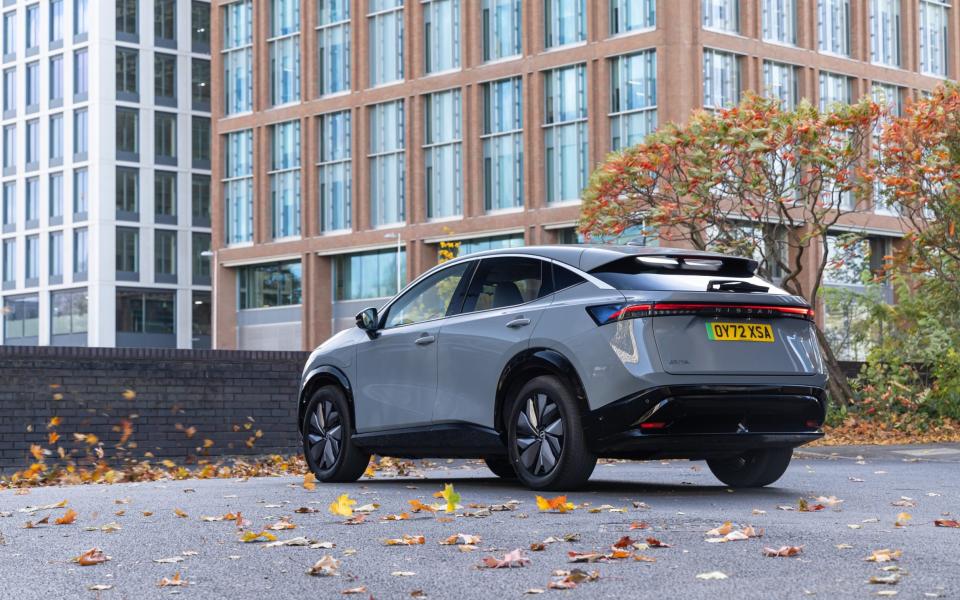
Our test car is a front-wheel-drive Evolve, which means it costs just shy of £56,000, a not-inconsiderable sum for a car with a Nissan badge. Of course, you could say the same about the Ford Mustang Mach E, which in extended-range form, with a battery only fractionally larger than the Ariya, costs almost £60,000.
That said, the Mach E is larger still (and faster) than the Ariya, and despite a battery that’s barely any bigger at 91kWh (usable), its 372-mile official range shades the Ariya’s 310-mile figure by quite some margin, so the extra cost is perhaps justified.
The Tesla Model Y, meanwhile, is faster still, and in long-range form with a 331-mile range, costs less than the Ariya despite also being larger.
Sizing up the competition
In size, the Ariya is actually closer to a Skoda Enyaq, a Polestar 2 or a Hyundai Ioniq 5, and a touch shorter than a Kia EV6 or a Toyota bZ4X. And it’s worth noting that all of these rivals cost less yet, despite their smaller battery packs, deliver more range.
That suggests the Ariya isn’t all that energy efficient, although its official figure of 3.4kWh is about average for the class. The same goes for charging speed which, at 130kW, is about on a par with the Skoda and Polestar, though slower than the Toyota, Hyundai and Kia.

This Evolve model is, as you’d expect, lavishly equipped, with heated seats in both rows, ventilated seats in the front, adaptive cruise control, a panoramic sunroof, Bose speakers, LED lights all round, a 360-degree parking camera and a huge suite of safety and driver assist kit.
Also of note is the fact you get a heat pump as standard on every Ariya, which makes Renault’s decision not to install one at all on the Megane E-Tech, in the UK at least, look even more bizarre.
The result is that the Ariya’s range shouldn’t drop off too severely in the winter – expect a minimum of around 215 miles in the coldest months – in contrast to the Megane, whose precipitous winter range is one of its biggest failings.
Inside appeal
Climb aboard the Ariya – and it’s a decent step up; this is a proper, tall SUV rather than any sort of crossover – and you’re greeted with a lovely swathe of faux suede that encircles the occupants, below which a fat wedge of what looks like open-pore wood (but probably isn’t) spans the dash.
There are copper-toned accents and flashes of chrome, and the ambient lighting includes glowing fretwork panels in the door panels and below the dash, whose pattern is reflected in the ankle-deep-pile carpet mats. The overall effect is lavish, and convincingly upmarket.
The two identical screens – one for the instruments, the other a touch-sensitive infotainment system – perch atop this. And when you turn on the car, touch-sensitive controls for the heating and ventilation glow through the wood grain, which looks very special indeed.
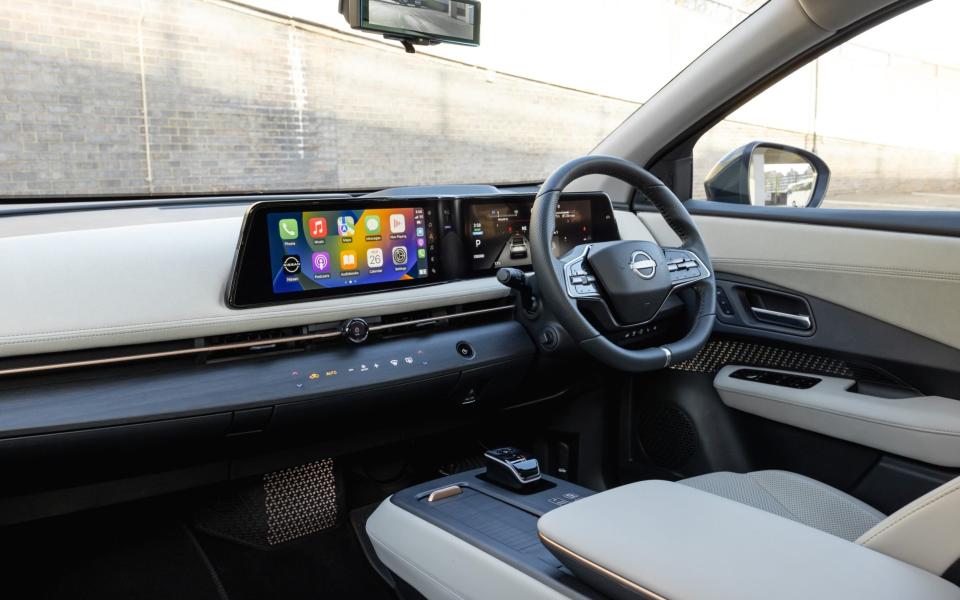
The infotainment system works well, with a sensibly laid out home screen, always-on shortcut keys, quick responses and smart, modern graphics, while a big rotary knob in the centre of the dash for the volume and power buttons means you can always turn the stereo down or off in a hurry.
The steering wheel controls are sensible, too – they’re glossy, and look touch-sensitive, but they’re actually a combination of buttons and roller wheels that feel intuitive and always give you a positive response in use.
We’re not huge fans of touch-sensitive climate controls, but the Ariya’s are at least easy to use – they’re oversized, so you don’t have to be finicky with your fingers to hit the right ‘button’, which makes them less distracting than most.
And the fact there’s a proper switch for the electronic handbrake – even if it’s oddly located beneath the dash so it’s a bit of a stretch – gives the Ariya an instant advantage over the Model Y, the Enyaq and the VW ID.4, all of which will only operate the handbrake automatically when you select Park.
A right old knees up
All good inside, then? Not quite – there are a few foibles. For one thing, the sweeping curve of the dash means it bows out toward the centre console; this means taller drivers will find their left knee knocks against it more or less constantly, which becomes mind-bendingly irritating over time.
There are some strange instances of seemingly needless overcomplication, too – for example, the whole centre console and armrest unit slides back and forth electronically. Just ahead of this, meanwhile, there’s a storage bin under the dash that opens using a complicated powered mechanism, directly adjacent to a glovebox with a flimsy lid that springs open manually. Why not simply give each compartment a nice, well-damped manual lid, and save some weight and cost?
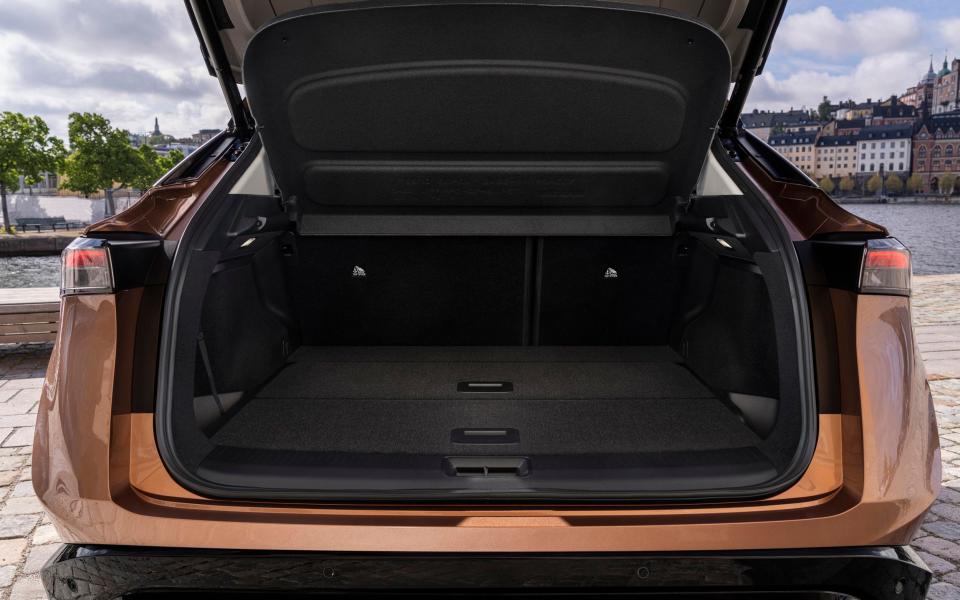
Then there’s the camera-based rear-view mirror, which requires your eyes to refocus each time you look at it, unlike a simple, conventional mirror, and is therefore incredibly tiring to use. Fortunately, there’s a switch at the bottom to convert it back to a normal mirror, which will likely be used once and never reversed.
With the exception of the driver’s left knee, the Ariya’s interior feels roomy, light and airy; in the back, there’s a simply vast amount of room, which easily puts it on a par with the Enyaq and Model Y in the space stakes, and of course the flat floor means those in the middle will have a decent amount of leg room.
The 466-litre boot can’t quite match those rivals’, though it isn’t bad going, and beats the Toyota and the Polestar; the boot’s a good shape, too, and the practical variable floor is split in two, so you can remove only part of it if that suits.
So far, it’s a fairly good showing for the Ariya, then, if not one that makes it stand out from the pack. However, once you get it out on the road, it starts to fall behind.
Sport psychology
Our test car was fitted with the £1,995 Sport Pack, which added leather upholstery and, notably, upgraded the wheel size from the standard 19 inches to 20.
As Andrew English noted when he drove the Ariya last, year, the ride quality even on the standard wheels is “plain annoying, feeling undersprung and overdamped as it corkscrews around at the back, crunches into anything with a sharp edge and never quite settles even at speed on the motorway”.
Add the 20-inch wheels to the mix and those characteristics are emphasised further. The Ariya in this specification is downright awful over potholed urban roads, its constant bobbling and crashing verging on the painful.
Even on smooth roads it manages to find bumps you can’t see, while there’s an incessant background vibration as though the tyres are managing to transmit even the grain of the asphalt to your posterior.
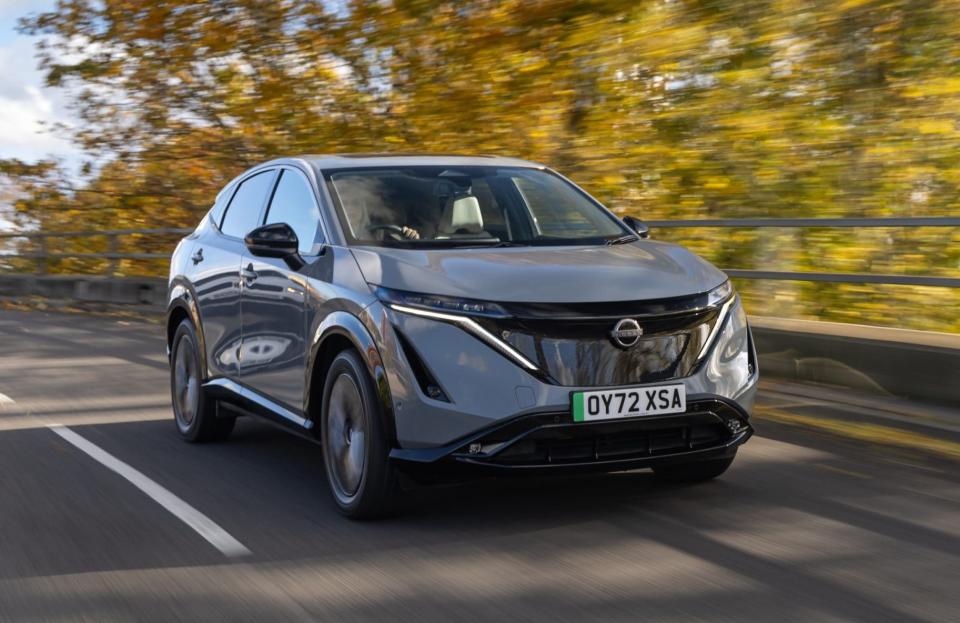
This is true even on a motorway, rendering the Ariya tiring for a long-distance trip; meanwhile, expansion joints clang through the car and surface changes are announced by a sharp change in tone from the tyres, which reminds you just how much noise they transmit.
The fallacy of all this is that the Sport Pack doesn’t even do a good job of bestowing any extra handling finesse; granted, it holds its line reasonably well in bends, but it feels ponderous and remote, as though it really isn’t happy about being pushed hard, and if you hit a mid-corner bump you’re pinged off-line by the ludicrously stiff suspension.
It’s not all bad news, however; for one thing, the pedal calibration is excellent with an accelerator that feeds in power progressively, so you don’t get silly amounts of wheelspin away from junctions, combined with a brake pedal that does such a fine job of blending regenerative and friction braking that you can’t tell where the latter takes over from the former.
The Telegraph verdict
As you might have guessed, however, it’s not enough to bring redemption to the Ariya. It is not a bad car, per se. There are real glimmers of ambition, not least in the beautiful finish inside, the spacious interior and the versatile boot, as well as the whopping equipment list.
The trouble is, these are all things you can say about its rivals – rivals which arrived longer ago, yet with more range, a lower price, faster charging, longer warranties and, crucially, much better ride quality.
The Ariya’s biggest problem, then, is that it doesn’t really bring anything new to the game. In an increasingly crowded part of the market, it tries to carve out a niche for itself only to find others have already been there and done that – and more convincingly.
It is, therefore, one of those cars that simply doesn’t give you a good enough reason to choose it – which, as it happens, is an accusation that can also be levelled at the second-generation Leaf. This truly is Nissan’s difficult third album, then; some nice tracks, for sure, but it’s hard to see it being remembered as a classic.
The facts
On test: Nissan Ariya 87kWh Evolve
Body style: five-door SUV
On sale: now
How much? £55,890 on the road (range from £46,145)
How fast? 100mph, 0-62mph in 7.6sec
How economical? 3.4mpkWh (WLTP Combined)
Electric powertrain: AC externally excited synchronous motor with 87kWh (usable) battery, 130kW on-board charger, Type 2/CCS charging socket
Electric range: 310 miles (WLTP Combined)
Maximum power/torque: 238bhp/221lb ft
CO2 emissions: 0g/km (in use), 36g/km (well-to-wheel)
VED: £0
Warranty: 3 years / 60,000 miles
Spare wheel as standard: no (not available)
The rivals
Tesla Model Y Long Range
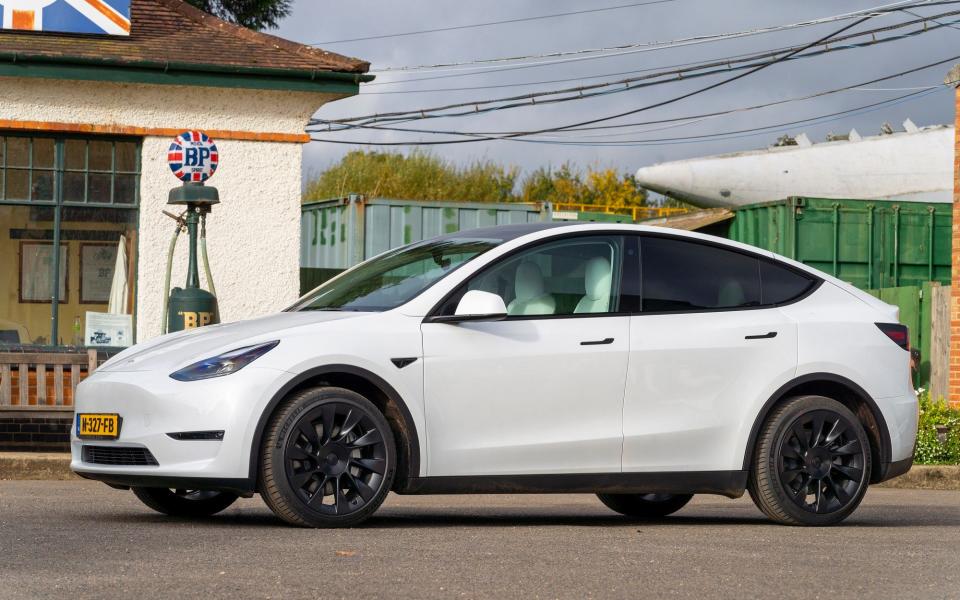
434bhp, 331 miles, £52,990 on the road
A quick look at the stats shows how the Tesla easily offers more for less than the Ariya. In the flesh, the comparison is less clear-cut, given the Ariya’s interior is plusher and more tactile (not to mention better built) and its kit list is more extensive. Still, the Model Y will be the car to beat for many buyers – and the Ariya might not quite pull it off.
Kia EV6 GT Line S RWD Heat Pump
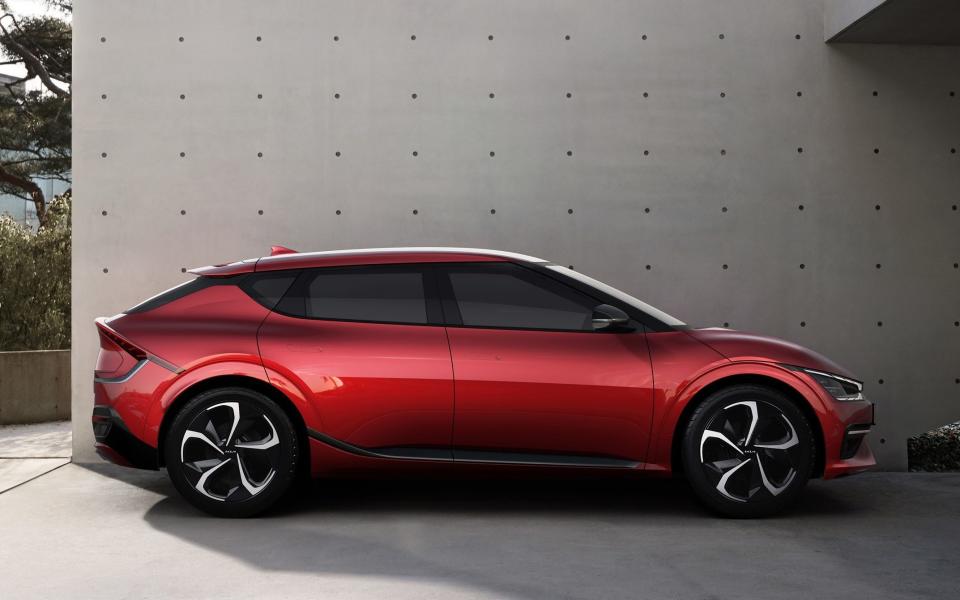
226bhp, 314 miles, £53,645 on the road
Still our favourite electric car, although this isn’t our favourite version. Yet even this top-of-the-range EV6 beats the Ariya on value and matches it for surprise-and-delight features inside. It’s every bit as well equipped, too, and you get a longer warranty to boot. It’s also slightly better to drive – although smaller-wheeled EV6s are better still.
Skoda Enyaq iV 80 EcoSuite Plus

201bhp, 338 miles, £49,405 on the road
If you’re after a big, comfy EV, the Enyaq is still where it’s at. It’s a touch down on power compared with the Ariya, but if you can live with that the Enyaq will go further on a charge, and do so much more smoothly. True, the interior is less high-quality, and there are some usability issues with the touchscreen and controls. But it’s also even roomier than the Ariya, and this EcoSuite model has lovely, sustainably sourced, brown leather.

 Yahoo News
Yahoo News 
